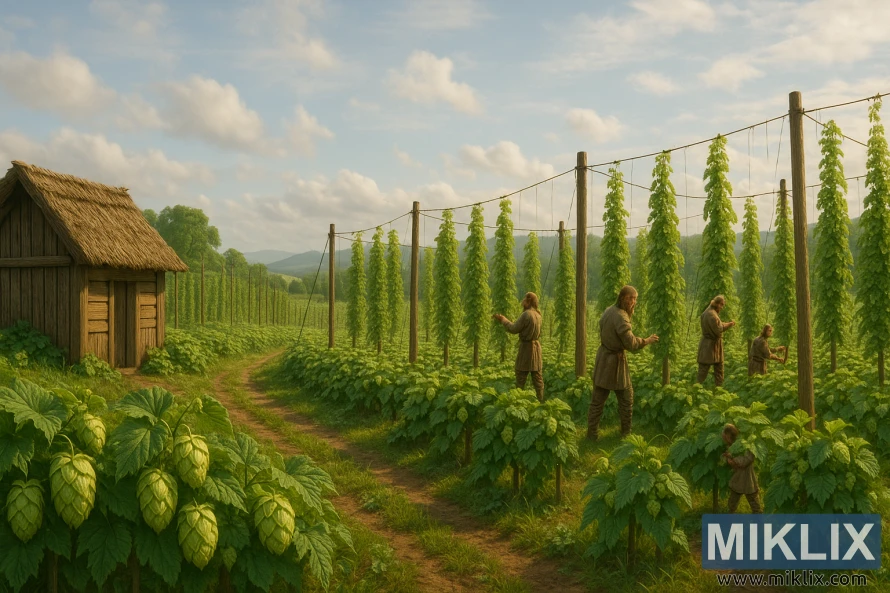Image: Viking Hops Field
Published: August 5, 2025 at 2:18:33 PM UTC
Last updated: September 27, 2025 at 9:50:19 AM UTC
A lush Viking hops field with farmers tending vines by a rustic shed under warm sunlight, set against rolling hills and an azure sky in a timeless scene.
Beneath a wide northern sky streaked with drifting clouds, the Viking hops field stretches outward in perfect rows, a living tapestry of green that speaks to both nature’s abundance and human care. Each bine climbs eagerly up its supporting pole, reaching toward the heavens as though drawn by some invisible force, the tightly clustered cones dangling in rhythmic cascades. Sunlight filters through the clouds, soft but steady, draping the landscape in a golden warmth that enhances the verdant hues of the plants. At the edges of the field, the soil is dark and fertile, bearing the marks of careful cultivation, while pathways meander between the rows, worn by countless footsteps of farmers who have walked here generation after generation.
To the left, a weathered wooden shed stands with a thatched roof, its form humble yet enduring. The rough timbers, hand-hewn and aged by countless seasons, seem to carry the memory of centuries, whispering of the harvests it has sheltered and the tools it has stored. Its presence grounds the scene, a reminder that though the field is alive with growth and energy, the rhythm of farming relies upon sturdy tradition and the patient hand of the cultivator. The shed is more than a simple outbuilding—it is an anchor of continuity, a silent witness to the cycles of planting, tending, and harvesting that sustain the community and its brewing craft.
In the middle ground, Viking farmers move among the towering bines with practiced precision. Clad in woolen garments, their attire blends seamlessly with the earthy tones of their surroundings, as though they are as much a part of the land as the plants themselves. One stoops low, inspecting the cones at eye level, assessing their size, color, and resinous aroma. Another reaches upward, guiding the vines, ensuring that they remain securely attached to their climbing supports. A child, perhaps an apprentice to this generational craft, lingers nearby, mimicking the gestures of his elders, his small hands brushing against the cones with a curiosity born of both play and duty. Their movements are deliberate, slow, imbued with a sense of reverence; they are not merely tending crops, but stewarding a resource central to life, celebration, and survival.
The background unfolds into a panorama of rolling hills and distant forests, their muted greens and blues softened by the haze of distance. Beyond the immediate labor of the field lies the vastness of nature, a reminder that the Vikings lived in close partnership with the land, drawing strength from it but also respecting its cycles. The mountains on the horizon suggest permanence, a steady presence that has seen countless generations pass and countless harvests come and go. Against this timeless backdrop, the hop fields and their caretakers appear as both ephemeral and eternal—temporary in the span of centuries, yet vital in the ongoing story of their culture.
There is a profound harmony in the scene, where human endeavor and natural growth are seamlessly interwoven. The hops, prized not only for their preservative qualities but also for their distinct bitterness and aroma, represent more than agriculture; they are threads in the cultural fabric of Viking society, supporting both the ritual of brewing and the communal bonds forged over shared ale. The light, the land, the people, and the plants together create an atmosphere of serene productivity, a portrait of balance between labor and abundance, tradition and nature. It is an image that encapsulates the essence of Viking hops cultivation, evoking both its practical significance and its symbolic role in the ancient art of brewing.
The image is related to: Hops in Beer Brewing: Viking

